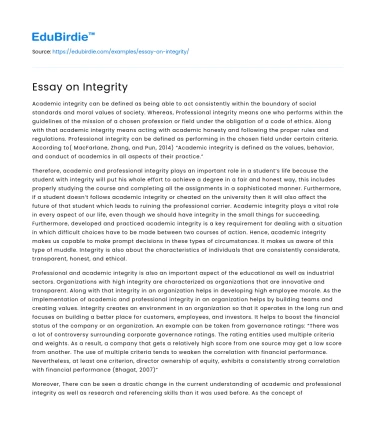Academic integrity can be defined as being able to act consistently within the boundary of social standards and moral values of society. Whereas, Professional integrity means one who performs within the guidelines of the mission of a chosen profession or field under the obligation of a code of ethics. Along with that academic integrity means acting with academic honesty and following the proper rules and regulations. Professional integrity can be defined as performing in the chosen field under certain criteria. According to( MacFarlane, Zhang, and Pun, 2014) “Academic integrity is defined as the values, behavior, and conduct of academics in all aspects of their practice.”
Therefore, academic and professional integrity plays an important role in a student’s life because the student with integrity will put his whole effort to achieve a degree in a fair and honest way, this includes properly studying the course and completing all the assignments in a sophisticated manner. Furthermore, if a student doesn’t follows academic integrity or cheated on the university then it will also affect the future of that student which leads to ruining the professional carrier. Academic integrity plays a vital role in every aspect of our life, even though we should have integrity in the small things for succeeding. Furthermore, developed and practiced academic integrity is a key requirement for dealing with a situation in which difficult choices have to be made between two courses of action. Hence, academic integrity makes us capable to make prompt decisions in these types of circumstances. It makes us aware of this type of muddle. Integrity is also about the characteristics of individuals that are consistently considerate, transparent, honest, and ethical.
Save your time!
We can take care of your essay
- Proper editing and formatting
- Free revision, title page, and bibliography
- Flexible prices and money-back guarantee
Professional and academic integrity is also an important aspect of the educational as well as industrial sectors. Organizations with high integrity are characterized as organizations that are innovative and transparent. Along with that integrity in an organization helps in developing high employee morale. As the implementation of academic and professional integrity in an organization helps by building teams and creating values. Integrity creates an environment in an organization so that it operates in the long run and focuses on building a better place for customers, employees, and investors. It helps to boost the financial status of the company or an organization. An example can be taken from governance ratings: “There was a lot of controversy surrounding corporate governance ratings. The rating entities used multiple criteria and weights. As a result, a company that gets a relatively high score from one source may get a low score from another. The use of multiple criteria tends to weaken the correlation with financial performance. Nevertheless, at least one criterion, director ownership of equity, exhibits a consistently strong correlation with financial performance (Bhagat, 2007)”
Moreover, There can be seen a drastic change in the current understanding of academic and professional integrity as well as research and referencing skills than it was used before. As the concept of academic integrity before the 18th century was totally different because at that time people did not use to give more importance to integrity as their priority was to maintain their good names. But nowadays in this modern era integrity is seen as the priority in every field whether its educational or industrial field academic integrity is regarded as the monitoring tool for self-empowerment.
On the other hand, Research is defined as the creation of new knowledge or using the provided knowledge in a different and creative way. It means knowing about facts and details of a given field or course content and giving new ideas or a new look to the content. And referencing is the acknowledgment of the other's contributions to our work which means providing evidence to our research or work with the help of supporting evidence from other researchers or writers. As can be seen that research and referencing nowadays are easier and faster than they used to be. There are different sources of research from which we are able to assess each and every piece of detailed information in a second. There are two methods of research primary and secondary research. Primary research means research made from different surveys interviews and any other experiments, it is also known as first-hand research. And secondary research means the way of collecting information from different journals or articles. It is made after primary research.
In my perception, there is a lot of change in understanding of academic integrity before as the character of higher education is changing. Before there used to be a narrow meaning of integrity but nowadays it is advanced or broad. This means nowadays academic and professional integrity is used as a sustainable and lifelong process for undergraduates. Therefore, integrity is like a part of our body without which we are not able to function properly or do the right things. Likewise, academic and professional integrity is essential in every educational as well as the industrial sector for sustainable development and the long run.
In conclusion, Integrity is one of the main principles for better leadership. It means being honest to others as well as to ourselves. So in every sector integrity is crucial for survival.
References
- Topics, Sample Papers & Articles Online for Free. (2016). The importance of Academic Integrity. [Online]. Available at: https://studymoose.com/the-importance-of-academic-integrity-essay[Accessed: 8 Apr. 2019]
- Bhagat, Sanjai, Bolton, Brian, and Romano, Roberta. (2007) The Promise and Peril of Corporate Governance Indices. Retrieved August 9, 2009, from http://shareholdercoalition.com/ECGIProxyRatingStudyOctober2007.pdf
- Vicere, A. A. (1985) ‘Creating Order from the Chaos: Academic Integrity in Continuing Professional Education’, Adult Education Quarterly, 35(4), pp. 229–239. DOI: 10.1177/0001848185035004005.






 Stuck on your essay?
Stuck on your essay?

